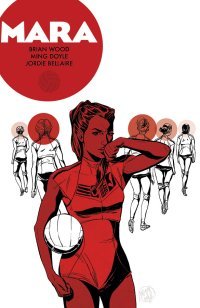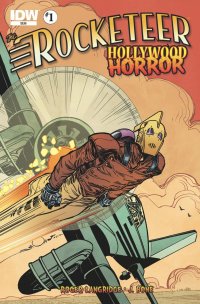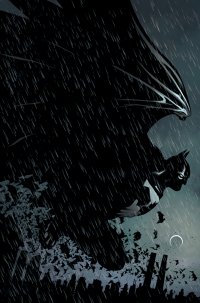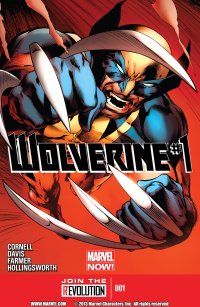Mara #3 ($2.99, Image)
by D.S. Randlett (@dsrandlett)
In my short time writing for Thor’s Comic Column, I’ve written a lot about Brian Wood. It’s been a busy year from him, what with Star Wars, The Massive, Conan, and now Mara. And that’s not even touching on his recent X-Men work. But here, we should probably start with artist Ming Doyle. She’s been working for a while now, probably coming into most people’s lives via the delightful blog, Project Rooftop, where she combined her tasteful style, with its heavy fashion-world influence, and an obvious love for comics into a series of tasteful and fun superhero costume redesigns. Her designs show a love for the genre, and part of the thrill of them was seeing her voice for these characters unburdened by corporate mandate. Yet, despite her being generally well regarded in the field, she has yet to really hit the big time. I suspect that this is for many of the same reasons that someone like Paul Pope remains on the mainstream’s margins: her non-comics influences bring a sense of delicacy and eroticism to her work, which unfortunately doesn’t seem to fit under what the Big Two publishers deem acceptable for their workhorse genre.
Mara is very much a superhero book, despite its dystopian sci-fi trappings. The writing features Wood at his most punk rock since the now-classic Demo, and he writes to Doyle in much the same way that he wrote to Becky Cloonan in 2003, as he’s crafted a world and a story that embraces all of Doyle’s influences. The title character begins the story as a star athlete, and she runs in circles immediately obvious to anyone who sees tabloids in line at the supermarket. The culture that Wood and Doyle have conceived is much like the one in Azzarello and Rizzo’s Spaceman, in that it feels eerily familiar in terms of its celebrity culture, but here it is beauty that throws its chains over the human soul rather than a shallow internet culture driven by crushing inequality.
The world of Mara seems to almost be a utopia, but by the third issue we start to see some hints of its brutal edifice. Inequality and constant wars. Sound familiar? But even in the rarified atmosphere that the book’s title character inhabits (for now), the culture of commercialism and wealth acts as a prison. Which is where superheroes come in.
More than most current superhero books, Mara really gets at why superheroes have been such a staple in our culture since Superman first arrived. Superman himself was created as more or less a vehicle for depression era outrage. The aspects of his status as a male power fantasy with his ability to shed his nerdy exterior in favor of his true, heroic nature have been well documented, but his (and the superhero in general) status as a vehicle for the articulation of class resentment. Superheroes are modern folk heroes. Where Herakles subdued nature to make the world safe for the rise of the city, the superhero subdues the city to make it safe for the individual soul.
Mara gets this. It’s no coincidence that Mara’s burgeoning powers arise with a sense of dissatisfaction with her life of privilege. She is, in effect, a sort of Marxist product: at once a product of a commercial culture at its zenith and the symbol of its eventual demise. The themes of this story serve as a critique of modern commercial culture, but they also shed light on the problems that plague the modern superhero story by grasping onto the core ideas of liberation and rebellion that are at the core of the genre’s inception.
Rating: 




Out of a Possible 5 Stars
 THE ROCKETEER: HOLLYWOOD HORROR #1-2 (IDW, $3.99)
THE ROCKETEER: HOLLYWOOD HORROR #1-2 (IDW, $3.99)
By Adam Prosser
I realized something the other day: I’ve only read one (1) issue of The Rocketeer that was actually written and drawn by its creator, Dave Stevens. It’s an old back issue of Pacific Presents, in which the comic was serialized in the 80s, and as such it’s completely out of context. Like most people, my experience with the character is tied to the 1991 Disney film. But that’s not actually that surprising, when you consider that Stevens only ever produced, if I’m not mistaken, 2 miniseries of a couple issues/installments each. I’ve written before about the somewhat problematic nature of characters that are handed off to other writers and artists, for whatever reason, but I don’t think any character has as big a discrepancy between the amount of work produced by its creator and the material that gives it its prominence in pop culture.
That said, the movie’s obviously great and basically true to the material, and some of the people who have given us Rocketeer comics since Stevens’ untimely death have been talented folks as well. But none of them were Roger Langridge!
Langridge is an amazing fit for the material for precisely the same reasons that he might at first seem like an odd one. To a lot of people he’s primarily known for his work on The Muppet Show comic, an amazing, acclaimed book that had the misfortune of being undercut by corporate mergers and rights issues (Disney, which owns the Muppets, bought Marvel–maybe you heard?–which means that BOOM! studios lost the rights to the characters.) He’s also been producing a great Popeye book, which is the kind of thing that people don’t appreciate because while everyone KNOWS Popeye, most people don’t really appreciate how great his comics and cartoons can be. But it’s clear from this and Langridge’s other work (a lot of which can be found online–google around for it) that the guy has a passion for old comic strips, and that he appreciates them on a different level than the average comics nerd.
To many, Golden Age comics are simply pulpy forerunners to our beloved superheroes (a genre that really only took its modern shape in the Silver Age). But precisely because the familiar outlines of the superhero genre hadn’t been locked in during the 30s and 40s, some very odd stuff slipped through. In particular, there was far less division between superheroes and genres like horror, film noir and even cartoons, which is why Captain Marvel could hang out with a talking tiger or a character like The Heap could get his own ongoing strip. The constant invention of Will Eisner’s Spirit strip, which could be gothic one issue and lightly comic the next, is in some ways the best embodiment of the Golden Age style.
This eclecticism shows through in Langridge’s take on The Rocketeer, Hollywood Horrror. In addition to the familiar trappings of our familiar helmet-headed flyboy Cliff Secord and his sexpot girlfriend Betty, Langridge weaves in other familiar characters of the era like Monk and Ham, the sidekicks of Doc Savage (who Stevens had implied was the creator of the Cirrus X-3 jetpack that powers the Rocketeer) and fast-talking detective couple Nick and Nora Charles (with their dog Asta). There’s even a cameo by a character who bears a strong resemblance to Barney Google and/or Snuffy Smith. The end result is something that feels a lot like League of Extraordinary Gentlemen: 1939, but even when it’s not specifically referencing notables of the period there’s an interweaving of different tones, from humour to horror to melodrama, that strikes me as being very much era-appropriate.
The art is by J. Bone, whose style is somewhere between Darwyn Cooke and Langridge himself, and again it just feels perfect for the comic. It’s not an emulation of Golden Age style per se, but the ideas underlying it–the casual blending of cartooniness and “realism”, the heavy shadows and dynamic composition–are very much in keeping with artists of the period like Will Eisner and Jack Cole.
Other post-Stevens takes on The Rocketeer have been reverent but rather bland, as if everyone was afraid that putting their own stamp on the material would risk being disrespectful to Stevens’ memory. But the real disrespect, it seems to me, is to crank out comics featuring his character that don’t have a spark of life or excitement about them. With Langridge and Bone, that’s not a problem.
Rating: 




Out of a Possible 5 Stars
BATMAN AND ROBIN #18 (DC Comics, $2.99)
By Devon Sanders (@devonsanders)
This final page.
It is silent but it speaks to sadness, redemption, emptiness and loss. This final page.
The final page of Batman and Robin #18 is the culmination of writer Peter Tomasi and artist Patrick Gleason’s monumental tasks; taking Batman, a man who knows full well how to be a guardian and turned him into a father. In the doing, they took Damian Wayne, a child who when we first meet him, has no boundaries. He is purposely made unlikable; revealed as a born killer and very much isn’t any reader’s idea of what a Robin should be.
In Tomasi and Gleason’s short time with Damian Wayne, they accomplished the impossible; they allowed Damian to grow into something we thought he’d never be.
A son.
Batman and Robin #18 is the story of a father so desperately missing his only son.
In the pages of its sister publication, Batman Incorporated #8, Batman watched as his only son was killed and here is where you watch a man who stands side-by-side with a Man Of Steel absolutely crumble.
Patrick Gleason beautifully portrays all of this from a Peter Tomasi script; the feelings of hurt, the outrage and at times, the indignation. Gleason’s Batman/Bruce Wayne is a man on the verge of breaking. Gleason, with the final page, leaves you with nothing but a man. Gleason on one page strips away Batman and Bruce Wayne and leaves you with a man I thought I’d never see; a man without answers, a man trying so very hard to deal with what he’s lost. In that final page, he’s never been more of a father.
Rating: 




Out of a Possible 5 Stars
 Wolverine #1 (Marvel, $3.99)
Wolverine #1 (Marvel, $3.99)
By Jeb D.
Alright, alright, Marvel… Paul Cornell AND Alan Davis? Even if it’s yet another fucking Wolverine book, I at least have to check this out, particularly with DC having unceremoniously pulled the plug on Cornell’s Saucer Country, which made my year-end Top Ten for 2012.
I’ll admit that I generally find Logan easier to take as the grit upon which groups like the X-Men hone their soap, rather than front and center, but Cornell’s idea of Wolverine as the central character in a super-powered cop procedural has possibilities.
This first issue’s pretty straightforward: a madman is loose in a shopping mall with an alien weapon of immense power, and in Die Hard fashion, one of the patrons trapped in the rubble is Wolverine. Naturally, there are layers and motivations to be stripped away, and Logan’s befriending of the man’s young son takes a few twists and turns, sending Wolverine in pursuit of the alien threat behind the father’s actions. Equally by-the-book is his bantering with the police lieutenant as they survey the carnage, and his conviction that he might have somehow averted the disaster, and his determination to rectify that: “That family doesn’t lose anyone else today-not on my account!”
From Cornell, this is actually pretty thin stuff: apart from the body count (the poor possessed father fries several hostages on-panel), you wouldn’t know this was the guy behind books like Wisdom or Captain Britain, but he does hit the right action-hero notes, and never gets fussy; he knows how to keep things brisk, and the book races by so quickly that it surprised me when I got to the end.
But if this is not Cornell at his most imaginative, it’s a great showpiece for the work of Alan Davis. Though I associate his recent work more with the cosmic (Fantastic Four: The End) or the fantastical (the “Everything Burns” Thor crossover), he brings spectacular widescreen storytelling to the action movie that Cornell has written, and he’s ably supported, as usual, by inker Mark Farmer, and colorist Matt Hollingsworth. It’s a tribute to their work that my sense of the brevity of this issue didn’t leave me feeling short-changed, but rather exhilarated at how I’d been caught up in the visual experience.
No substitute for more of Saucer Country, I’ll grant you, but a must for fans of either Alan Davis or the bad-tempered mutant Canuck.
Rating: 




Out of a Possible 5 Stars